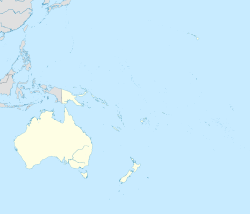|
Kómnzo language
Komnzo (also Kómnzo, Kómnjo, Kamundjo) is a Yam language of Papua New Guinea spoken by 150–250 people in the village of Rouku (8°42′06″S 141°35′55″E / 8.701793°S 141.598485°E) and the town of Morehead.[1] PhonologyConsonantsThe consonant inventory comprises 18 phonemes (ᵐb, t, ⁿd, k, ᵑɡ, kʷ, ᵑɡʷ, m, n, ŋ, ɸ, ʦ, ⁿʣ, ð, s, r, w, j). The system consists of a series of obstruents (oral and prenasalized plosives and affricates), fricatives, nasals and semivowels. Consonants occurring only in loanwords are: b, g, d, l.[1]
VowelsThe vowel inventory consists of eight phonemes (i, e, æ, a, ʏ, ø, u, o) and one epenthetic vowel (ə̆).[1]
EpenthesisKomnzo phonology exhibits widespread vowel epenthesis. The epenthetic vowel is usually a short schwa (ə̆), sometimes a short high front or high back vowel. Many syllables and many words in Komnzo lack a specified vowel, e.g. mnz 'house' [mə̆nts] or gwth 'nest' [ᵑɡʷə̆θ]. OrthographyIn the tables above, graphemes are indicated by <angle brackets>. The current orthography of Komnzo does not represent the epenthetic vowel because it can be predicted by the rules of syllabification. This leads to orthographic representations which untrained users might find hard to pronounce, for example: zfth 'reason' is pronounced [tsə̆ɸə̆θ] or fta '36' is pronounced [ɸə̆ta]. Numeral systemKomnzo number words use a senary numeral system, with the following powers: nibo (61), fta (62), taruba (63), damno (64), wärämäkä (65) and wi (66). Counting in larger quantities is restricted to a ritualized counting procedure, whereby yam tubers are counted publicly for exchange feasts. For everyday counting above six, English numerals are borrowed.
Notes
References
External links
|
|||||||||||||||||||||||||||||||||||||||||||||||||||||||||||||||||||||||||||||||||||||||||||||||||||||||||||||||||||||||||||||||||||||||||||||||||||
Portal di Ensiklopedia Dunia

